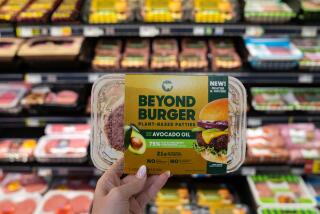Op-Ed: How we went from beef on the hoof to mystery meat in a box
What with all the vegetarians, vegans and flexitarians around, you might be surprised to learn that we now consume more animal protein than ever: 200 pounds per person in 2000, up some 40 pounds since the backyard barbecues of the 1950s. But no longer do we gorge on porterhouses, racks of lamb, pork roasts or spareribs. Today, much of the animal protein we eat has been stripped from the bone, doctored with chemicals and reformed into breakfast patties, lunch nuggets and microwaveable entrees.
Most people would attribute this shift to our squeamishness about slaughtering, butchering and preparing meat, and to our puerile taste buds.
But consumer preferences are not what led supermarkets to carry refashioned animal tissue. The Ur-culprit here is the U.S. Army, which since the early 20th century has been on a relentless quest to reduce the cost of the meat it feeds soldiers. Demand, in this story, followed supply.
For centuries, having a bone in our dinner had been an insurance policy — an indispensable feature for quick and easy identification of the animal and body part in question, as well as a vital clue as to its overall fitness for consumption. Only the poor gnawed on unrecognizable remnants, mostly in stews and soups.
Then came World War I. The military and its meatpacking friends in Chicago suddenly found that they needed to supply 4.7 million troops with a pound of protein a day. Obviously it couldn’t send whole carcasses overseas — not in such large quantities. Desperate to keep supplies running, the Army’s Quartermaster Corps asked itself: Could it go against humankind’s antipathy to barrels of unidentifiable chunks and scraps, long disdained as containing tainted meat?
In 1918, the Army — with the help of Lt. Jay Hormel (doesn’t that name sound familiar?) — set up a beef processing plant and distribution system centered in Chicago. The results caused Army bigwigs to do a little jig: a quarter-carcass weighed 25% less without its bones, fat and cartilage. When frozen into a rectangular solid, wrapped in burlap and waxed paper, and stacked, it occupied 60% less space on crowded trains and ships.
By World War II, the Chicago meatpacking companies Armour and Swift had gotten in on the act, working with the Navy Veterinary Department to invent more efficient deboning techniques, sort the meat by class and flash freeze the flesh so that it maintained a fresh appearance and texture.
Crowed the War Department in 1946: “Military advances in beef processing have made the beef ration a reality almost everywhere our present global Army may be. The Army has put boneless beef — frozen fresh and packed … on a basis where further experimentation is not necessary. It is now ready for civilian use.”
Not quite.
In fact, it took the rise of the supermarket, and the replacement of the old meatpacking business model (traditional butchery by tradesmen in cities along train lines) with a new one (assembly-line butchery by unskilled workers near rural feedlots along the federal highway system) before civilians accepted the economic and practical benefits of boxed, boneless meat. From 1963 to 2002, the percentage of boxed beef shipped from the nation’s largest slaughterhouses increased from less than 10% to 60% of total sales, and now accounts for more than 90% of the beef sold in supermarkets.
The military didn’t stop with deboning. As soon as boxed meat was widely available, Army brass set itself the modest goal of reducing the meat bill 60%. It would buy the cheapest parts and figure out a way to make them look and taste like the more desirable whole-muscle cuts.
Military food scientists went into the laboratory and began to fiddle, as well as to contract with universities and industry for outside research. They and their collaborators improved meat flaking equipment, invented meat glue (a mixture of meat ooze, salt and other chemicals), and discovered that adding phosphate improved juiciness, texture and flavor. Together, these developments allowed them to paste together bits and scraps that could then be molded into a chop, cutlet or steak tasting roughly like the real thing.
By 1972, the Army’s fake-muscle-cuts project had successfully manufactured pilot runs of grill steaks, Swiss steaks, minute steaks and breakfast steaks. It started serving the troops restructured veal cutlets in 1976, followed by lamb and pork chops and, somewhat later, beefsteaks. Soon, these Frankenfoods were standard fare in the MRE (Meal, Ready to Eat).
Once the military had accomplished its goal, it stepped back, letting the private sector replace the government as the chief promoter and developer of restructured meat, its appetite whetted by the value-added proposition of making something from practically nothing.
University and industry food science departments looked for ways to further reduce manufacturing costs. This included hot deboning (while the corpse is still steaming), de-sinewing, mechanical separation (pushing a carcass through a sieve), blending fat and trim into protein “sludge,” and collection of plasma for use as a plumper. Items produced using these exotic techniques debuted in fast-food restaurants, and appeared a bit later in the frozen foods section and then finally in the supermarket refrigerator case.
Consumption of restructured meat products exploded in the 1990s and the early years of the 2000s, so much so that in 1997, the Census Bureau had to add a new industry code — nonpoultry meat processing — which that year generated $24 billion in sales. By 2007, it accounted for $37 billion.
Americans began the 20th century clinging to their T-bones and prime ribs. But, thanks to the military, we no longer demand bodily evidence as to the origins and wholesomeness of our dinner. We have even learned to prefer eating animals in the forms pioneered by the Army: boneless and restructured. Bon appetit, America.
Anastacia Marx de Salcedo is the author of “Combat-Ready Kitchen: How the U.S. Military Shaped the Way You Eat.”
Follow the Opinion section on Twitter @latimesopinion and Facebook
More to Read
A cure for the common opinion
Get thought-provoking perspectives with our weekly newsletter.
You may occasionally receive promotional content from the Los Angeles Times.










